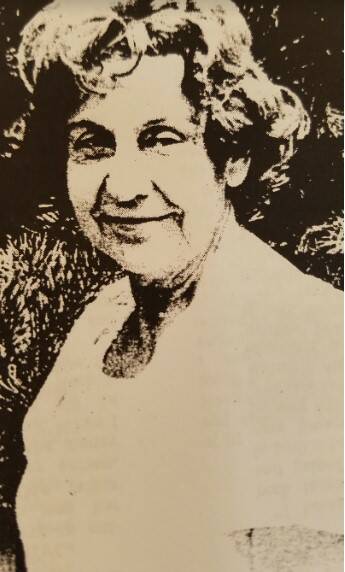The Fern Howe story was originally written by Dick Reed and published in the Sept. 15, 1974, issue of the Brown County Democrat.
Fern Keeler Howe was born at Pogue, Ill., near Edwardsville, which is near East St. Louis. Three months later her family moved to Kokomo, Indiana, her father’s hometown. Her mother came originally from Greentown, Ind.
Mr. Keeler owned a machine shop in Kokomo. He also had five of his own rings, or crews, each with complete equipment for custom harvesting and threshing. Normally, one crew would work in Iowa, another in Illinois and three in Indiana.
“My father was a catholic and very liberal, even by today’s standards,” according to Fern. “Mother was a Quaker. But I always wanted my folks to be Methodists and Republicans like all the rest of the people in the community! One of my sisters is catholic. The other sister and I are Quakers.”
When farmers got their new combines, fathers harvesting business became unprofitable,” says Fern. “So he opened a good sized machine shop in Kokomo. After he died, mother supported us all by running a restaurant in Kokomo. Then we moved to New Castle where mother ran the hotel dining room. My sisters went to New Castle high school, and I went into nurses training at the IU Indianapolis Medical School.
“I graduated in 1929 with a Registered Nurse degree. Later I earned a bachelor’s degree in nursing education and the equivalent of a bachelor’s degree in education, both from Ball State. It was then I returned to Indiana University for a master’s degree in education which I received in 1953. That was a total of nine years in college, interspersed with my jobs during all those years.
“My first job with the extension division of the Indiana University, was demonstrating the need for school nurses and county nurses throughout the state. I got in on the last of a six-year program in 1929 and worked that final year in northern Indiana counties. Then I went on to the Indianapolis public health staff of the visiting nurses association.
My husband, Glen E. Howe, was a Spiceland boy whom I met in New Castle. He was with the Army Engineers when we were married at New Castle in 1953. Glen had been assigned to Haiti and developed both malaria and yellow fever, so he had been reassigned to office work in Columbus, OH.
“From 1953 to 1955 I was head nurse at the New Castle State Hospital-the first Registered Nurse they’d ever had. I re-organized the whole department and staffed a new 70-bed “acute” hospital there, supplementing what had been mainly a family unit type of care. We had 325 attendants and 1,000 patients in the whole operation. The old hospital was turned into a tuberculosis unit. I hired more Registered Nurses and staffed the 70- bed acute hospital with a supervisor Registered Nurse around the clock.”
Fern was always an outdoors lover. So was her mother. But her father was not a country person, except he liked the money he made harvesting. “When I was seven years old, he bought a farm near Rochester Indiana, and we lived there for five years.” Fern’s sisters, each younger than Fern were both born on the farm near Rochester, they are Ruth Crim of Ormand Beach, Florida and Lucille Marcum of Albuquerque N.M. Each has one son and one daughter. All the girls were raised by their mother after their father died.
“I enjoyed the woods and fields, the ice skating, our horses and ponies. But not the one-room school. The only school period I actually liked was recess. No one could have convinced me, then, that I’d ever become a teacher.
“The only church in our area was Methodist, which neither of my parents attended. I went to the Methodist Sunday School but not to their church services. One day when I was 11 years old, the minister came by to talk to my father about a contribution to paint the church. Father asked him some questions but didn’t get any answers. The minister didn’t know how big an area there was to paint, how much the paint would cost or how many coats it would take. Father finally sent him on his way after writing a check for $50.
“Then he told mother; If I didn’t know any more about my business and ran my business like that preacher runs that church; I wouldn’t have the $50 to give him to paint the building. No wonder he didn’t have the $50.”
To be continued.
Submitted by Pauline Hoover, Brown County Historical Society





